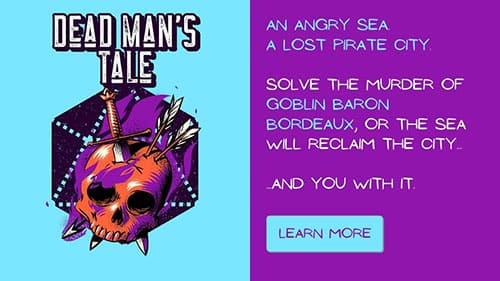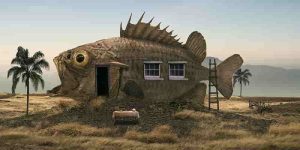Underwater adventures in Dungeons and Dragons 5e can open a unique world of aquatic cities, monsters and landscapes for players to explore.
When building an Underwater Campaign in DnD 5e, consider the following elements and prompts:
- How do the characters breathe?
- Underwater Combat
- Varying environments beneath the sea
- Sunken Pirate Ship Adventure
- Lovecraftian Temple Adventure
- Undersea Dragon Slayers
Before we dive in, we’ve created a pirate mystery adventure! Check it out here or below.
How do the characters breathe?
First, we need to get the basics out of the way—our characters need to breath. Some races have this ability built-in, such as a triton. Others can hold their breath for a decent amount of time, such as lizardfolk and tortles.
However, we don’t want to pigeonhole our characters into a handful of races that can operate underwater. Therefore, we can include freebie magic water breathing items to launch our players into an underwater setting.
Also, we could use steampunk versions of underwater submersible ships to launch the adventure. Then, we could build tension with the actual threat of water filling up the ship. In fact, we could even pull from movies like The Abyss for events and encounters that crank up the thrill factor. Swim from pod to pod before running out of air, discover an unknown being in the depths, stop the pirates who go mad and try to destroy the fantastical being.
Underwater Combat
Unless a character has a defined swimming speed, typical melee attacks have disadvantage underwater. Naturally, you’re not going to swing a mace, sword or axe super effectively. However, piercing weapons like spears, javelins, daggers and tridents will attack normally. You can even fire ranged weapons like crossbows with the range lowered to its lowest distance. Long or short bows will have disadvantage.
Strong characters should consider grappling in an underwater combat scenario. It counts as an attack if you have multiple attacks, pitting your Strength against the opponent’s Strength or Dexterity. This way, you can still utilize that Strength score even if your attacks have less accuracy.
Related Posts:
Guide to Building Dinosaur Campaigns: DnD 5e
| Guide to Building Pirate Characters: DnD 5e
|
Tanks should also consider the Grappler feat. Once you grapple a creature, you gain advantage on your next attack. Therefore, you can cancel out the disadvantage you would otherwise have with a Strength-based melee weapon. Plus, another successful grappling roll will allow you to pin the opponent, restraining you both.
Varying environments beneath the sea
Underwater environments are just as diverse as the environments on land. Sure, everything pretty much looks covered in water, but climate and geography affect these places, too. Volcanic geysers, colorful coral reefs, exotic animal life, glaciers and undersea caves could all paint an underwater landscape in different ways. Consider the following examples to spark your setting concept:
- Coral Wilderness: Take the colorful, diverse ecosystem of a coral reef and amplify it to fantastical proportions. Discover coral mazes, find pearls or hunt an undersea predator in its lair.
- Bubble Cities: Merfolk or triton cities could exist underwater—much like the mythical Atlantis often does in the comics. We can take from Star Wars: The Phantom Menace and create bubbled pods of breathable air—manageable spaces for the amphibious inhabitants.
- Lost Caves: Underwater cave systems can lead to lost cities or temples hidden beneath the sea. We could borrow from Lovecraft to design these subterranean places—complete with pictographs of fish people. Check out my Underground Adventures article here.
- Icy Seas: Similar to the above idea, we can build an arctic environment with glacial constructs, caves and underwater cities. Perhaps this could be an arctic adventure via submersible.
Sunken Pirate Ship Adventure
Naturally, locating and exploring sunken ships for lost treasure is solid go-to for underwater adventure ideas. In fact, this adventure idea is great place to start from a tavern. Of course, this tavern would be a salty pirate bar on the coast. Once the peg-legged bartender mentions treasure, we’re off to the adventure.
This is a great opportunity to utilize a map and puzzle scenario for your players to put together. Characters can roll skill checks for clues to the location of the sunken trip. On the other hand, we could implement a cypher puzzle with elements of the map that spell out a majorly helpful clue for the party to follow.
Once the sunken ship is located, we can further build out the adventure. Consider one of these scenarios.
- A tentacled predator has made its lair in the wood of the old craft, which conceals the creature in its hull.
- Puzzle locks keep a mysterious amulet inside the cabin safe, unleashing cursed pirate spirits when opened.
- A friendly spirit, Captain Jack, is trapped in limbo—forever haunting the boat. Find his lost sword in the nearby coral wilderness so he can move on.
Lovecraftian Temple Adventure
Undersea caves offer opportunities for air pockets and lost civilizations. Naturally, these abyssal caves could have a Lovecraftian feel to them. Pictographs of fish people on the walls bow to an enormous and terrifying figure. Could it be a primordial being of ancient myth? Is it possible the party could wake it up? Is it calling to them?
A few elements you could include to spice this journey up include:
- An abandoned ancient temple with language cypher puzzles alongside the pictographs on the wall.
- Lurking monsters like cavefishers and other horrors that live in darkness
- Mindflayers! A cult of mindflayers could call the temple home.
- Gates to other dimensions.
- A sleeping, colossal monster
Undersea Dragon Slayers
Take the classic dragon slayer quest and place it in an underwater kingdom. Using the bubble city example above, we can place a kingdom in peril beneath the sea. A sea serpent or other humungous sea monster is destroying cities and coral farms. Now, your players party arrives from another land (the surface) just in time to solve the problem.
- Begin with conflict. Either the party has been summoned out of desperation or have been captured and must make a bargain for freedom.
- Hunt through the coral wilderness. The quest to find the creature’s lair cuts through colorful coral wilderness, where characters will need to discern directions, fight predators and explore.
- Seek the mysterious lair. Now, the characters will find an underwater cave. We can use scarier, tentacled creatures to inhabit the cave.
- The boss fight. Finally, the characters encounter a challenging monster fight of a gigantic or colossal nature.
Related Posts:
Guide to Building A Coastal Druid Circle of the Land: DnD 5e
| Guide to Building Steampunk Adventures: DnD 5e
|






